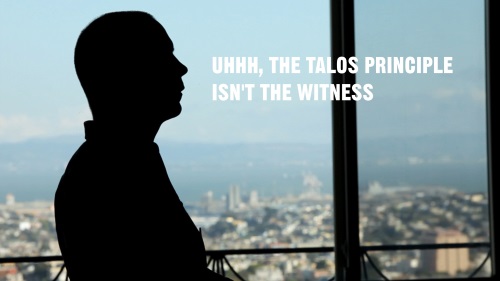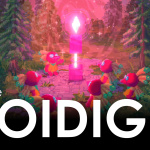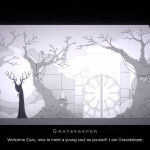I am helpless before The Witness (Thelka, 2016). I don’t mean it’s difficult, I mean I just can’t stop playing it. It presses my buttons hard. It’s a miracle I can tear myself away to write something about it.
Here are some key points about what The Witness is and why it’s good. I’ll talk a little about structure, but won’t spoil any of the puzzle solutions so you can read with impunity.
A few years ago I saw some footage of The Witness and my response was scepticism. I didn’t talk about it, because “reviewing previews” is like the most goddamn boring thing in the world. But the game looked terrible in conception: pretty world with lots of puzzle panels scattered about. All I could see was one of the major frustrations of puzzle game design writ large: how to make puzzles feel like a natural part of a virtual world? It seemed that designer Jonathan Blow had shrugged and chosen to seal his puzzles in little picture frames, protected from the environment.
I wondered if the excellent The Talos Principle (Croteam, 2013) would have stolen its thunder because there seemed commonalities. Strange, beautiful places that are crumbling into ruins spoilt by the presence of incongruous advanced “puzzle technology”. These games even share laser beams. But Talos’ puzzles are three-dimensional and players have to study each puzzle arena in pursuit of the solution; every puzzle in The Witness appears to be a single flat frame. It just sounded less ambitious.
I’m sure you’re already ahead of me – soon after starting The Witness all that scepticism was jettisoned into the sun.
We start out penned in a small area in which we – ah, a tutorial. To get out of the tutorial pen, we have to grapple the basics of panel interaction. Each puzzle is a maze in which we have to draw a line from a starting point to an exit. Solving a panel will usually activate or unlock something else, but here the panels offer no real challenge other than tracing cables around.
Throughout this, the game communicates nothing to us other than the controls. Getting out of the pen is quite the moment: we’re free, free to go anywhere we want. Well, I’m stretching the truth a little bit, because we’re kinda herded towards some more training sections for real challenges but we don’t have to do them. We can go where we want.
But The Witness cannot help but tease us with the complexity that we’re ill-prepared for. This is the first puzzle we find outside the pen.
We’re being taught that we might not be able to complete puzzles at first glance so don’t feel bad about buggering off if you can’t figure it out; you may not be ready, Daniel-san. The Witness stops telling us where to go and that’s important because many of the puzzles are about logic, learning rules and finding the solution to satisfy particular puzzle configurations. But those rules only become clear if we take on the right training puzzles so we keep exploring, trying to unearth clues to what the hell this puzzle might mean.
During my travels, I’ve noticed none of the over-reaching and poorly-implemented complexity of something like the glowing green objects that resisted time-reversal in Jonathan Blow’s debut title, Braid (Number None, 2008). But not all of the panels are not solved using straight-up logic. Some puzzles are like locks where the key has been hidden in the surroundings; some of these won’t trouble you for long but others deliver proper pat-yourself-on-the-back moments when you crack them. The environmental design here is absolutely spot on.
It’s obvious that not all of the puzzles are compulsory but, nonetheless, I’m going to do my damnedest to solve them all. So far, there’s only been one sequence of puzzles that managed to outstay its welcome. There’s a long chain of panels behind a castle which is not difficult to solve after figuring out the trick but they go on and on and on, getting more obnoxious with each iteration.
I think Talos might have suffered if The Witness had come out first due to the surface similarities, even though they’re completely distinct experiences. Let’s talk about one of the big differences between the two, which is in story. Talos uses many established game narrative devices – the audio log, readable lore, the bog standard expository British God – to convey a fleshed out backstory and plot. The Witness feels a tad more experimental and I say that because I haven’t a ruddy clue what it’s about. I’ve learnt that an earlier version of The Witness delivered exposition about the island and what you had to do, but there’s nothing of the sort in the final release. There are audio logs, but, well, you’ll see. Or hear, rather. (To be frank, I was reminded of Dear Esther.)
All you have to go on is what you see. Whether it’s possible to work out the origins of this strange island, I don’t know, but ultimately if all that fails it’s fine as it is.
Here’s the thing. If you hated the heavy-handed impenetrable exposition of Braid, you’ll have to strain to find it here. The island itself is its own story and if you think that’s just as “pretentious” good luck. We talk a lot about “show and not tell” and letting the player discover the mechanics without the crutch of a boring tutorial, but pulling that off successfully is game design magic. Blow offers magic here but he’s tried to go the whole hog and strip away the story exposition crutch too. I don’t yet know if this works because there’s… there’s a problem.
In last month’s film Into the Black, I suggested exploration-based objectives could damage the joy of exploration. The Witness suffers from this. I find myself running around hunting puzzles, hungry for tangible progress, spending little time appreciating the heavenly glory and musing on meaning. Admiration but not contemplation.
It pains me to admit this because it is fascinating place to explore, closer to the Gone Home school of compact, dense design than the sparsity of a modern open world game. Like Dishonored (Arkane Studios, 2012), the island of The Witness looks painted rather than real and is home to all sorts of illusions which can occasionally stop you in your tracks.
There’s one other thing I really like about The Witness. It restricts player movement in the same way as the early alphas of Kairo (Locked Door Puzzle, 2012) – no jumping, no falling, invisible walls all the way. But Kairo developer Richard Perrin took out the invisible walls due to negative feedback. Eliminating jumping and falling means no falling accidents and no flinging yourself across gaps again and again because you’re sure you can do it this time. In a cerebral puzzle game, you don’t want to be worrying about your parkour abilities. I am pleased not to have to worry about that extra dimension although it does take some getting used to; it’s second nature to hop over a wall or rock instead of walking around it.
I think this is a good place to stop for now. Once I’ve finished The Witness, I may write a little more about the puzzle design.
NOTES
- Lovely article from Dan Griliopoulos on how The Witness has evolved from 2011 to now. But WATCH OUT or you will witness some puzzle spoilers.
- I’m drawing lots and lots and lots and I also feel like I need to draw a map of the island. It’s not large, but physical obstacles stop you from moving in straight lines.
- Although the solutions of some panels are to be found in the environment and the panels have some impact, it still seems the presence of the puzzle panels is arbitrary. Talos went down the Portal route, explaining the puzzles were tests. There’s no obvious justification in The Witness but I actually don’t mind that much. I’m comfortable dealing with the island as an abstraction and not expecting it to represent a real entity.
- Update 03 Feb: From Twitter today. Willy Chyr (Manifold Garden) is finding The Witness more like work now and wouldn’t continue playing if he wasn’t making a puzzle game. Alan Hazelden (Sokobond, A Good Snowman is Hard to Build) has found the final area of the game to have soured the experience. Well, well, we will see.
Download my FREE eBook on the collapse of indie game prices an accessible and comprehensive explanation of what has happened to the market.
Sign up for the monthly Electron Dance Newsletter and follow on Twitter!













Interesting! Like Talos, I’ve not really paid much attention to The Witness, although both have been on my radar and both I am keen to play at some point. I’d love to know which of the two you prefer and whether I ought to play one before the other…
Hi Gregg! It’s a tough call right now. My guess is The Witness feels like it has more “variety” and not about honing your skills across a set of tools. They’re both very good in their own right. I suspect Talos will feel less vibrant than The Witness if you play Talos second, but I dunno, Talos offers obvious story and depth (if you’re willing to indulge in lots of reading). Speculation!
Nice write-up. I have finished the first aspect of The Witness just recently and am much interested in your take on it as a whole. I too am jelly before this game; as Kairo and Talos are some of my best gaming experiences.
I found myself basically obsessed with The Witness. I’ve had frustrations with it: No spoilers, but the ‘ending’ was a massive anticlimax because I’d been playing for 4 days straight and it seemed like I’d have to start over. (Don’t worry, you can reload from just before that point.) After that though, finishing up the puzzles I’d missed (and whole areas I’d not found) has been really satisfying. I’m not sure if I’ll have the patience to properly 100% the non-panel-puzzles though.
Thanks Zholistic, I’m already adding a huge batch of notes for a spoilery Witness, so I think it’s going to happen.
Sam, I’m already a little worried about the “narrowing” of the game as I slowly work through the low hanging fruit and have to deal increasingly with puzzles I don’t understand. I am still obsessed at the moment! I’m not exactly sure what you mean by non-panel puzzles right now but I’m sure I will…
Joel, I am just commenting to say that I cannot properly comment, in fear of spoiling anything for anyone.
+1 for the obsession list here, obv.
I think I just shat myself a little when I discovered a major thing 20 hours into the game. Also, off-panel puzzles (actually, off-panel clues that don’t seem to relate to nearby panel puzzles) are driving me mad. WHAT DOES IT ALL MEAN?
Ketchua, my journey continues. Let’s hope I can get this game finished “soon” so I can open a spoilery thread and we can all have a merry conversation about the game.
I guess you’ve discovered that the rabbit hole with this one is deep… (!) I’m still falling down it at 40 hours in.
Yes Zholistic. Still going!
I cannot afford this game. I am sad.
A great contrast between meaningless exploration and objective-driven exploration. The former can get really boring after a while, while the latter lends a sense of accomplishment but risks boxing the player in with puzzles that may be too hard to solve. Meanwhile the mysterious third kind — the one with a narrative arc that’s there but doesn’t hand itself out to you — is probably the ideal, especially with some objectives to add further structure. Paint the story onto a world and let the viewer admire the painting, then come away having seen what they’ve seen. Some will see nothing! Having gotten so used to here’s-the-story exposition in our games, learning to find the story is almost like learning to flex a long-unused muscle.
The Witness is on my wish list, for sure. I look forward to more thoughts on it from you, HM!
Hi Steerpike! Oh I’ve soaked a lot of hours into The Witness now. I’m close to the finish line, sorta, and I have a lot of things to say. I’m not sure what the ending reveals, if anything, but the game does feel very light on the narrative scale. That isn’t to say there is *nothing* to glean here, but it’s not telling a plot, so to speak. I really like this.